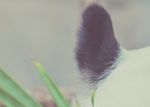The Gut Microbiome and Energy Source of the Giant Panda
←
→
Page content transcription
If your browser does not render page correctly, please read the page content below
The giant panda is a very distinctive species and its highly fibrous diet consists of bamboo to a 99%. Studies have suggested the panda's digestive capacities have adapted to this peculiar diet. Not just that, but their phenotype as well. However, how the panda acquires energy from this plant remains largely a mystery. A metagenomic study was performed to shed light on this subject.
Case Study Introduction The giant panda (Ailuropoda melanoleuca ) represents one of the endemic flagships of China. The species is distinctive in the sense that, unlike the rest of its superfamily, Arctoidea, the giant Panda species' diet is solely on bamboo . The bamboo's dry mass is mostly composed of cellulose, hemicellulose and lignin. Previous genomic studies revealed the giant panda lacks the homologues necessary to transcribe proteins capable of degrading cellulose. Moreover, their gastrointestinal (GI) tract is characteristic of carnivores. As a result, it's hypothesized the giant panda needs the presence of cellulose-degrading bacteria. Previous studies have identified some cellulose-degrading bacteria in their faces, while others did not find that the panda gut microbiome had the capacity to degrade cellulose[1, 2]. This study[3] provides evidence on this hypothesis. Wenping Zhang, an expert researcher at the Chengdu Research Base of Giant Panda Breeding, has done previous work on the genetic diversity, gut microbiome composition, and more, on the giant panda. The Research Institute is highly recognised for conservation and research into rare and endangered animals, in particular, the giant panda. Experiment design 332 feces of 12 giant pandas were analyzed using shotgun metagenomic sequencing. Metagenomic analyses consist of studying the genetic material (e.g. DNA) extracted from the environment such as water, solid, stool, and even nutrient medium of cultured microorganisms. The sample is filtered and purified, leaving only the extracted DNA strands to be sequenced and subsequently put together with assembly methods. Metagenomic analyses are done to understand the complexity of diversity, host- microbe interactions, metabolic pathways and microbiome population. Certain sequenced genomes provide useful taxonomic information. Approximately 10 phyla were identified, the most abundant ones being Firmicutes and Proteobacteria. Other phyla identified were Enterobacteriaceae, Streptococcaceae, Lactobacillaceae, Clostridiaceae, Campylobacteraceae and Veillonellaceae . © 2011-2021 Novogene Co., Ltd. All Rights Reserved Information and specifications are subject to change at any time without notice. Please contact your Novogene representative.
Case Study
Sampling 332 feces from 12 giant pandas
Sequencing 57 samples selected
Shotgun metagenomic sequencing out of 322
De novo assembly of contigs
Assembly
Pan-metagenome for contigs
Metagenomic Taxonomy annotation & Gene prediction & Metagenome linking group
Analysis abundance analysis function annotation (MLG) construction
Functional analysis of
KO function gene CNV
cellulose degradation
Panda get energy
from bamboo?
By carbohydrate-active enzymes comparison By CNV comparison
Figure 1. Research pipeline of the study
KO models and comparative metagenomic studies were performed to pinpoint the cellulolytic and hemicellulose
activity, lignin metabolism and overall carbohydrate activity genes in the giant panda's genome.
The workflow consisted of taking 332 feces from 12 giant pandas, identifying their taxonomic profile using 16S
rRNA sequencing. Out of the 332, only 57 samples were analyzed using Shotgun Metagenomic techniques, and the
sequenced fragments were assembled. Afterwards, came the functional analysis of the samples:
a) taxonomy annotation and abundance analysis;
b) identifying the gene-encoding genome regions in the DNA;
c) using the aforementioned KO models to pinpoint the involved genes.
The final results are analyzed comprehensively to build hypothesis on how the panda extracts the much-required
energy from the fiber-rich bamboo.
© 2011-2021 Novogene Co., Ltd. All Rights Reserved
Information and specifications are subject to change at any time without notice. Please contact your Novogene representative.Case Study
Conclusion
The research demonstrated there is an age-associated variability of the giant panda's life stages and its intestinal
flora. Fecal material analyses demonstrated the panda's gut microbiome composition remains stable after the
first year of life. The GI of very young pandas possess a higher expression of genes-encoding enzymes capable of
metabolizing simple sugars. Comparative analyses of metagenomic showed that the giant panda also expressed
two pancreatic amylase gene copies, while carnivore species only display one[4].
The panda's digestive physiology is adapted to surviving on hemicellulose, maximizing the amount of energy
that is possible to acquire from its degradation. NGS technology allowed specialized teams, such as the one from
Great Panda Research base, to acquire more knowledge on the topic of the giant panda's genomic expression, GI
composition and how it affects each one of its life stages.
Novogene continues to supply trusted next-generation sequencing services to help researchers achieve their
goals. By combining metagenomics study, Novogene uses NGS technologies with the latest advancements
in bioinformatics for data analysis, and helps researchers capture metagenomes without the painstaking
steps of isolation and cultivation of each individual species in the lab.
Novogene has vast experience in multiple microbial sequencing, including 16S/18S/ITS rRNA amplicon
metagenomic sequencing, metagenomics sequencing for genomic profiling and meta-transcriptomic
sequencing for transcriptome studies. Bioinformatics package is offered to assist with the complete data
analysis, from taxonomic diversity to functional annotation of genes.
References
[1] Transcriptional Regulation and Adaptation to a High-Fiber Environment in Bacillus subtilis HH2 Isolated from Feces of the Giant
Panda. Zhou Z, Zhou X, Li J, Zhong Z, Li W, et al. (2015) Transcriptional Regulation and Adaptation to a High-Fiber Environment
in Bacillus subtilis HH2 Isolated from Feces of the Giant Panda. PLOS ONE 10(2): e0116935. doi: https://doi.org/10.1371/journal.
pone.0116935
[2] Hirayama, K., Kawamura, S., Mitsuoka, T. and Tashiro, K. (1989), The faecal flora of the giant panda (Ailuropoda melanoleuca).
Journal of Applied Bacteriology, 67: 411-415.doi: https://doi.org/10.1111/j.1365-2672.1989.tb02511.x
[3] Zhang W , Liu W , Hou R , et al. Age-associated microbiome shows the giant panda lives on hemicelluloses, not on cellulose[J].
2018. 12:1319–1328. doi: https://doi.org/10.1038/s41396-018-0051-y
[4] Amylase copy number analysis in several mammalian lineages reveals convergent adaptive bursts shaped by diet. Petar Pajic,
et al. bioRxiv 339457; doi: https://doi.org/10.1101/339457
© 2011-2021 Novogene Co., Ltd. All Rights Reserved
Information and specifications are subject to change at any time without notice. Please contact your Novogene representative.You can also read


























































